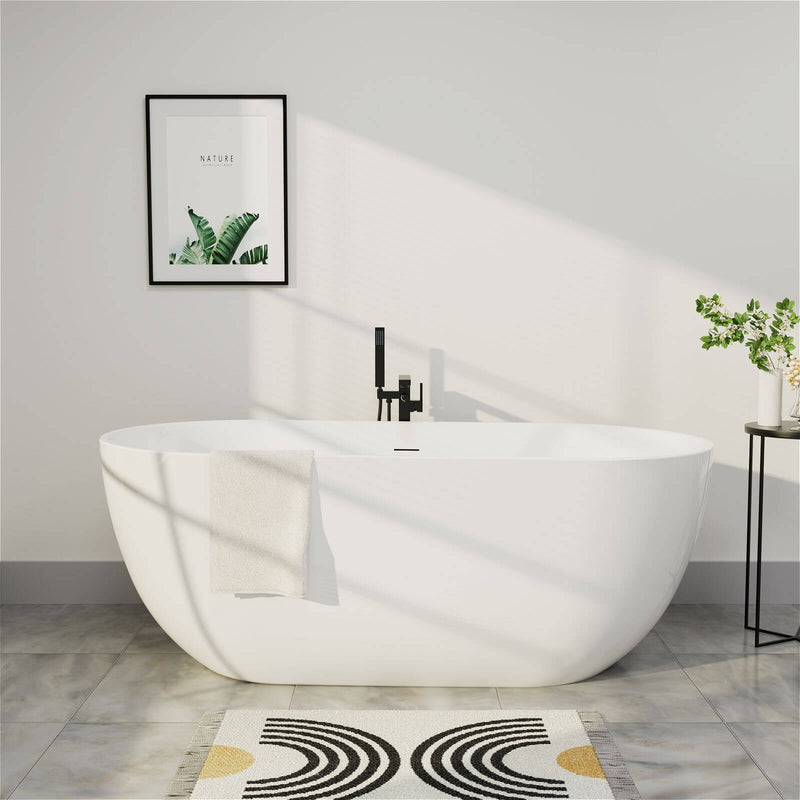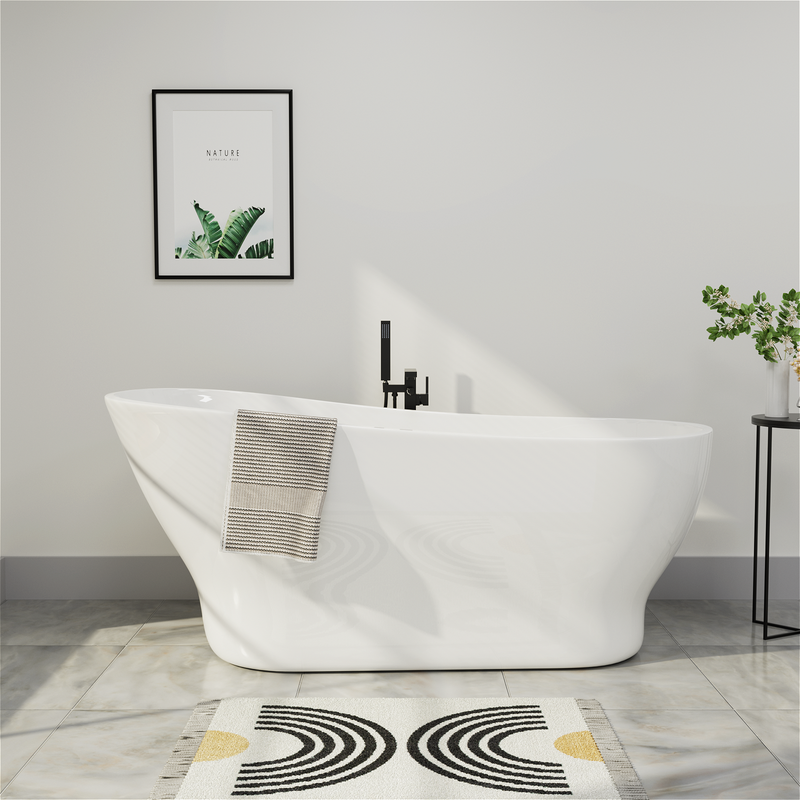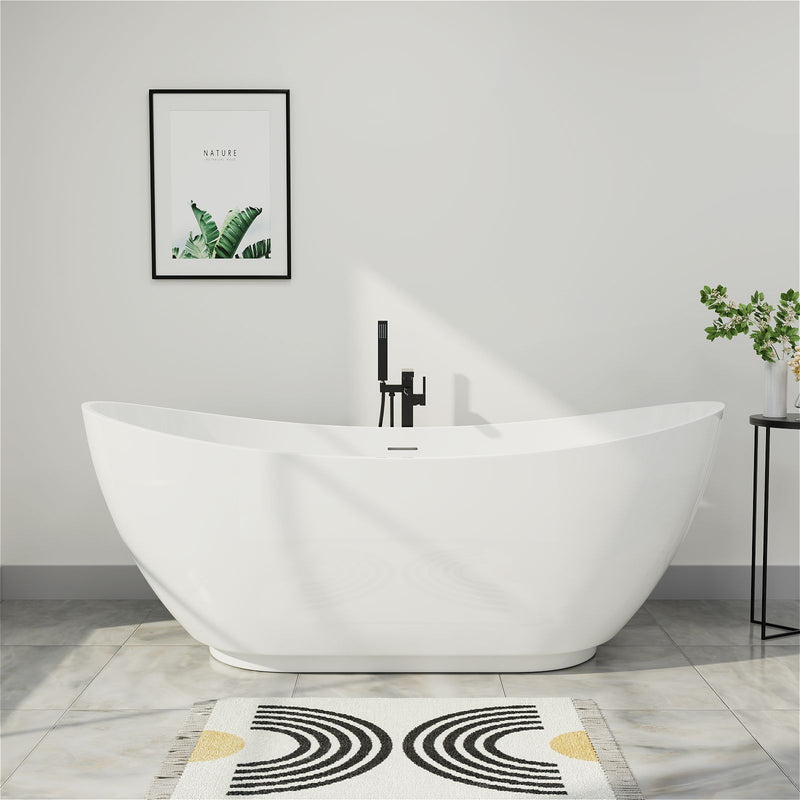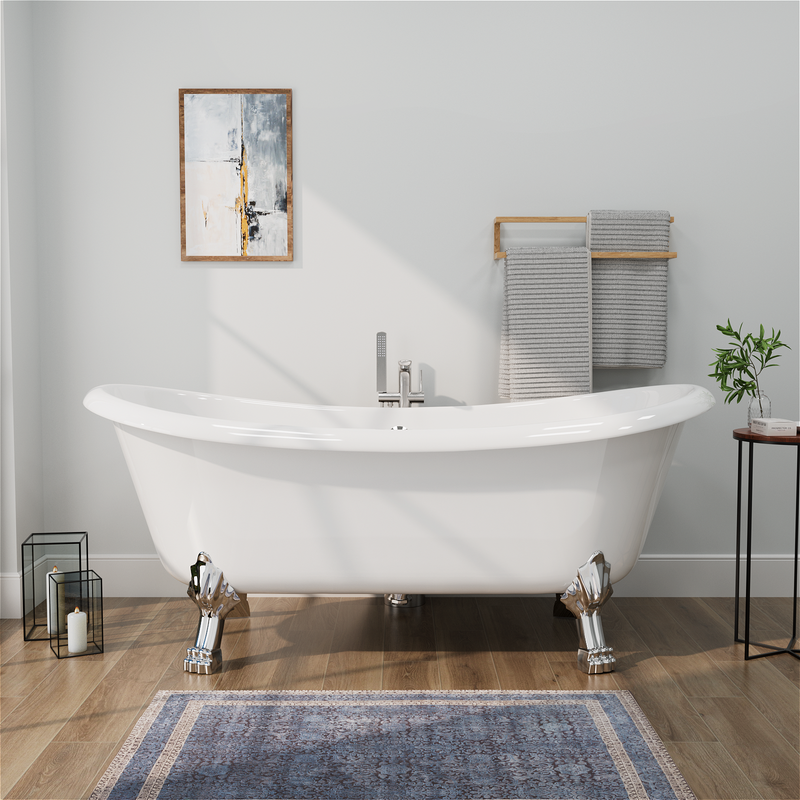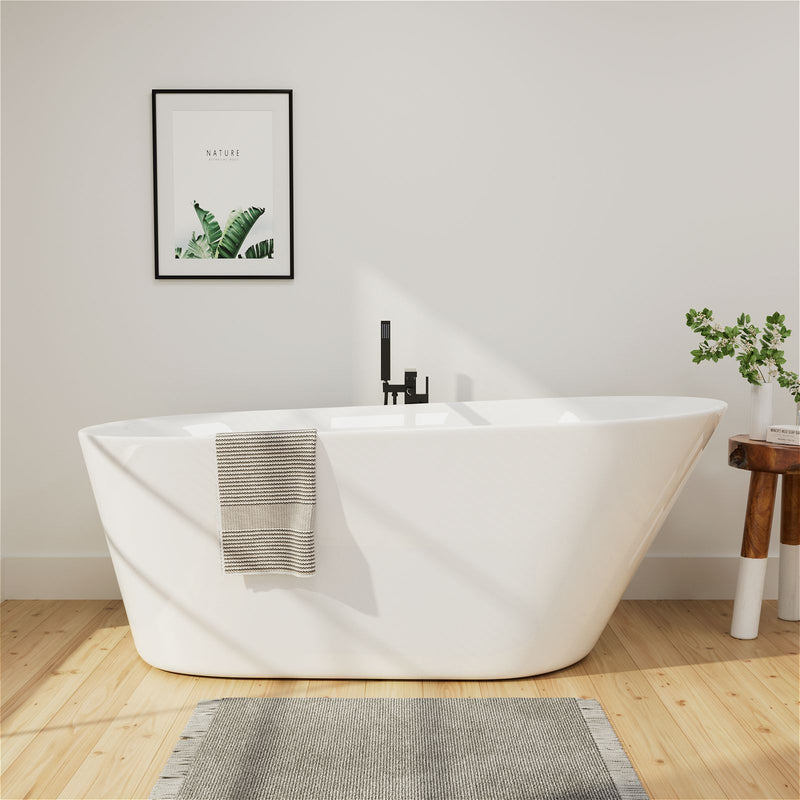A small bathroom shouldn't mean sacrificing the luxury of a tub. With thoughtful planning and creative design, even the most compact spaces can accommodate a soothing bathing retreat. The key is selecting the right tub and designing the layout to maximize every inch. Modern solutions range from space-efficient freestanding tubs to innovative built-in options that transform limited spaces into functional spas. This comprehensive guide explores the best small bathroom tub ideas, offering practical solutions that combine style, comfort, and smart space utilization without compromising on aesthetics or functionality.
Freestanding Tubs for Small Spaces
Freestanding tubs have made a remarkable comeback in bathroom design, and contrary to popular belief, many contemporary models are perfectly suited for smaller spaces. These tubs offer flexibility in placement and can serve as stunning focal points that enhance the perception of space through their elegant forms.

Compact Oval and Round Tubs
Traditional freestanding tubs often conjure images of large, clawfoot designs, but today's market offers numerous compact versions specifically designed for small bathrooms. Look for oval or round tubs with reduced footprints that still provide comfortable soaking depth. These designs often measure between 55-65 inches in length, making them ideal for positioning against a wall, under a window, or even in a corner. Their curved shapes create better traffic flow around the bathroom compared to angular designs, enhancing the sense of space while providing full bathing functionality.
Slipper and Soaker Tubs
For those who prioritize deep soaking experiences, compact slipper tubs offer an excellent solution. These single-ended designs feature a raised back that provides comfortable support for neck and shoulders, allowing for a relaxing bath in an ergonomic position. Modern small-space versions maintain the elegant slipper profile while reducing the overall footprint. The key is selecting models with space-efficient dimensions that prioritize interior bathing space over exterior bulk. Many contemporary designs achieve this through vertical proportions and ergonomic interior contours that maximize comfort without requiring excessive floor space.
Placement and Layout Considerations
The advantage of freestanding tubs in small bathrooms lies in their installation flexibility. Unlike built-in models, they don't require surrounding frameworks or decks, creating a lighter visual presence. Position them diagonally in corners to maximize floor space or centrally to create a striking focal point. The space beneath and around the tub can be visually incorporated into the overall bathroom, making the room appear larger than it actually is. This approach, combined with strategic lighting and reflective surfaces, transforms the tub from a space-consuming necessity into an asset that enhances the perception of spaciousness.
Built-In and Drop-In Tubs
For bathrooms where every inch counts, built-in and drop-in tubs offer space-efficient solutions that can be customized to fit specific dimensions. These tubs integrate seamlessly into the bathroom structure, creating a streamlined look that maximizes functionality.
Alcove Tubs
Alcove tubs, designed to fit snugly between three walls, represent the most space-efficient option for small bathrooms. This classic configuration makes excellent use of what would often be dead space while providing a comfortable bathing experience. Modern alcove tubs come in various sizes, with compact models available for particularly tight spaces. The integrated walls on three sides mean less cleaning surface and a more cohesive look. Many manufacturers offer shorter and narrower versions of standard tubs that maintain comfortable interior dimensions while reducing the external footprint. This approach works especially well in bathroom layouts where the tub can double as a shower base, maximizing functionality in limited square footage.
Drop-In Tubs for Custom Solutions
Drop-in tubs offer exceptional flexibility for small bathrooms because they can be installed into custom-built surrounds that match the exact available space. This approach allows for tailored solutions that standard tub sizes cannot provide. The surrounding deck can incorporate valuable storage, display areas, or even built-in seating. For truly compact spaces, consider reduced-depth drop-in tubs that focus on comfortable seating rather than full reclining. These can be particularly effective in creating a Japanese-style soaking experience where depth matters more than length. The surrounding framework can be designed with retractable panels or doors to provide access to plumbing while maintaining a clean, integrated appearance.
Corner Tubs
Corner tubs represent one of the most space-efficient options for small bathrooms, utilizing what is often underutilized space. Modern corner tubs have evolved beyond the bulky Jacuzzi-style designs of the past to become sleek, angular soaking pools that make a dramatic style statement while saving space. Triangular, pentagonal, and other angular shapes can fit precisely into corners, with the diagonal orientation creating interesting visual dynamics that make the bathroom feel larger. Many contemporary designs feature asymmetrical forms that maximize interior bathing space while minimizing the footprint. When combined with corner windows or strategic mirror placement, a corner tub can become the centerpiece of a small bathroom that feels both spacious and luxurious.
Space-Enhancing Design Strategies
Selecting the right tub is only part of the solution for small bathrooms. How you incorporate it into the overall design significantly impacts both functionality and perceived space.

Visual Expansion Techniques
Several design strategies can make a small bathroom with a tub feel more spacious. Large-format tiles with minimal grout lines create a more seamless look that visually expands the space. Continuous flooring that runs throughout the bathroom, including into the shower area, creates a unified flow that makes the room feel larger . Glass shower enclosures or simple panels instead of opaque curtains maintain sightlines, making the entire bathroom feel more open and accessible. When these elements are combined with a carefully chosen tub, the result is a small bathroom that feels generous and well-proportioned despite its limited dimensions.
Storage Integration
In small bathrooms, finding storage space becomes particularly challenging when incorporating a tub. Creative solutions include built-in niches in surrounding walls, floating shelves above the tub, or vanity designs that extend alongside the tub platform. For freestanding tubs, wall-mounted trays and floor caddies provide bathing essentials without permanent space commitment. The key is selecting storage solutions that feel intentional rather than added as an afterthought. Recessed shelving in particular offers excellent functionality without encroaching on the limited space, keeping essentials accessible while maintaining clean lines and open areas.
Lighting and Color Considerations
Proper lighting and color selection dramatically affect how spacious a small bathroom with a tub feels. Layered lighting that includes overhead, task, and accent elements creates depth and dimension. Natural light from windows or skylights makes any space feel more open and airy. When it comes to color, light, monochromatic schemes typically make spaces feel larger, though some designers successfully use bold accent walls to create depth and character in small bathrooms. The tub itself can be a color statement in an otherwise neutral space or can blend seamlessly with the surroundings, depending on whether you want it to stand out as a focal point or recede visually.
Material and Feature Selection
The materials used for both the tub and surrounding elements significantly impact the functionality, maintenance, and perceived space in a small bathroom.
Acrylic and Composite Materials
For small bathrooms, lightweight acrylic and advanced composite materials offer practical advantages. These materials are easier to install in tight spaces and often feature excellent heat retention properties, keeping bathwater warmer for longer. High-quality acrylic tubs maintain their glossy finish with minimal maintenance and resist staining and mildew when properly cared for. Their non-porous surfaces need only a soft cloth and mild cleaner to maintain their appearance. Modern manufacturing techniques allow these materials to be formed into space-efficient shapes with ergonomic contours that maximize bathing comfort in compact dimensions.
Multifunctional Features
When space is limited, each element should offer maximum functionality. Consider tubs with integrated seating for easier access and safer bathing. Textured bottoms provide slip resistance in compact bathing areas where movement might be restricted. For tub-shower combinations, thermostatic shower systems ensure consistent temperature control in close quarters. Some space-saving tubs incorporate built-in storage for bath products within the rim or side panels, reducing the need for additional shelving. These multifunctional features enhance both safety and convenience in small bathrooms where every design decision must serve multiple purposes.
Installation Considerations
Proper installation proves particularly important for tubs in small bathrooms. Precise measurements are essential, as even slight miscalculations can significantly impact functionality in tight spaces. Professional installation ensures that plumbing connections are properly sealed and that the tub is perfectly leveled, which affects both appearance and drainage. For bathrooms on upper floors, verifying structural capacity is crucial, as the combined weight of a tub, water, and occupant can be substantial. These technical considerations might not be as visually apparent as design choices, but they fundamentally impact the long-term satisfaction with a small bathroom tub.
FAQs
What is the smallest tub you can install in a small bathroom?
The smallest standard tubs measure approximately 47 inches in length and 27 inches in width, though custom solutions can be even more compact. Corner tubs and compact Japanese soaking tubs often represent the most space-efficient options, with some models requiring as little as 25-30 square feet of bathroom space while still providing comfortable soaking experiences.
Can you really fit a freestanding tub in a small bathroom?
Yes, many contemporary freestanding tubs are specifically designed for small spaces. The key is selecting compact models with reduced footprints and positioning them to maximize floor space. Placing a freestanding tub diagonally in a corner or against a wall can actually make a small bathroom feel more open than a built-in tub, as the visible floor space beneath and around it enhances the perception of roominess.
Are tubs in small bathrooms difficult to clean and maintain?
Not necessarily. Alcove tubs with integrated walls actually have less surface area to clean than freestanding models. For freestanding tubs in small spaces, easy access to all sides simplifies cleaning. Materials like high-quality acrylic resist staining and mildew, making maintenance straightforward with regular care using non-abrasive cleaners.
What type of tub is best for a very small bathroom?
For extremely limited spaces, corner tubs, compact drop-in tubs with custom surrounds, and Japanese soaking tubs typically work best. These options maximize bathing experience within minimal square footage. The choice depends on whether you prioritize space efficiency, soaking depth, or multifunctional use as a shower.
How can I make my small bathroom with a tub look larger?
Several strategies enhance the perception of space: use large mirrors to reflect light and views, install glass shower panels rather than opaque curtains, choose continuous flooring throughout the space, and employ a light color palette with strategic accent colors. Proper layered lighting that includes both ambient and task elements also creates depth and dimension that make the room feel more spacious.
Is a tub in a small bathroom a good investment?
Yes, installing a tub in a small bathroom typically adds value to your home, as many homebuyers consider at least one bathtub essential. Even in compact spaces, a well-designed bathing area enhances functionality and appeal. The key is selecting a tub that fits the space appropriately rather than forcing in a standard-sized model that overwhelms the room.
Conclusion
Creating a functional and beautiful bathroom with a tub in a small space requires careful planning but delivers immense satisfaction. The ideal solution combines a properly sized tub with smart layout decisions and space-enhancing design techniques. Whether you choose a compact freestanding tub, a space-efficient alcove model, or an innovative corner design, the result can be a personal sanctuary that belies its modest dimensions. By focusing on proportional choices, multifunctional features, and visual expansion strategies, you can enjoy the luxury of a tub without compromising your small bathroom's functionality or style. Remember that in a small bathroom design, every decision should serve both practical and aesthetic purposes, creating a cohesive space that feels intentionally designed rather than merely filled with fixtures.

